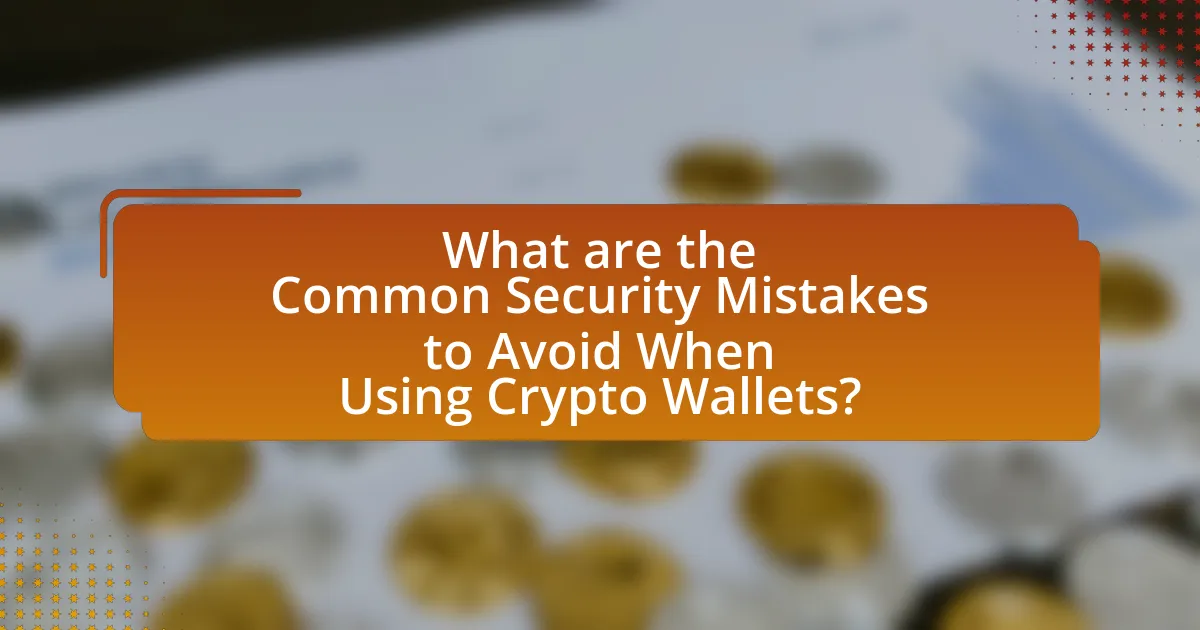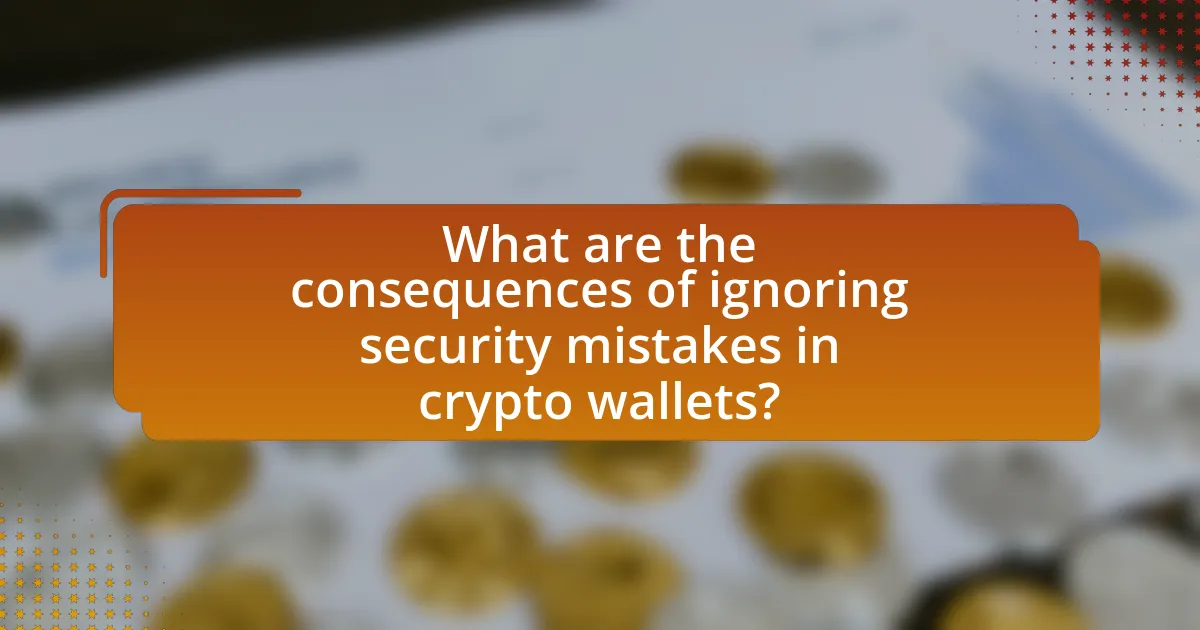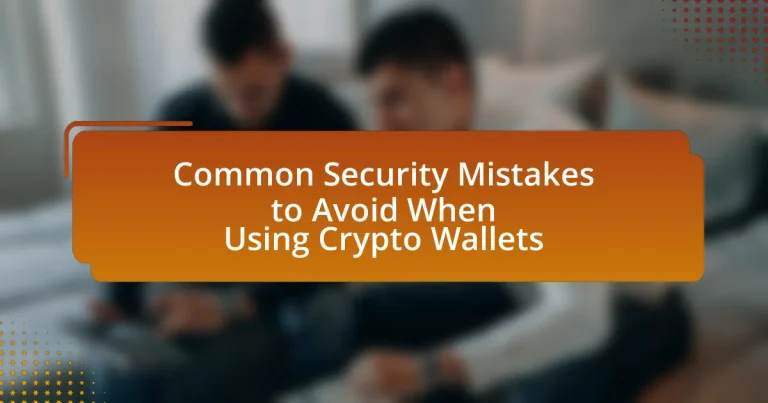The article focuses on common security mistakes to avoid when using crypto wallets, emphasizing the importance of securing digital assets. Key mistakes include using weak passwords, failing to enable two-factor authentication, and neglecting software updates, all of which can lead to unauthorized access and significant financial losses. The article outlines the potential risks associated with inadequate wallet security, such as theft and loss of access to funds, and provides practical tips for enhancing wallet security, including the use of strong passwords, regular software updates, and security audits. Additionally, it highlights the consequences of ignoring security measures and offers guidance on what to do if a wallet is suspected to be compromised.

What are the Common Security Mistakes to Avoid When Using Crypto Wallets?
Common security mistakes to avoid when using crypto wallets include using weak passwords, failing to enable two-factor authentication, and neglecting to keep software updated. Weak passwords can be easily guessed or cracked, leading to unauthorized access; studies show that 81% of data breaches are linked to weak passwords. Not enabling two-factor authentication increases vulnerability, as it adds an extra layer of security that can prevent unauthorized access even if a password is compromised. Additionally, neglecting software updates can leave wallets exposed to known vulnerabilities, as software developers frequently release patches to address security flaws.
Why is it important to secure your crypto wallet?
Securing your crypto wallet is crucial to protect your digital assets from theft and unauthorized access. Crypto wallets store private keys that grant access to your cryptocurrencies; if these keys are compromised, hackers can easily steal your funds. According to a report by Chainalysis, over $3.2 billion in cryptocurrency was stolen in 2020 alone, highlighting the significant risks associated with inadequate wallet security. Implementing strong security measures, such as two-factor authentication and hardware wallets, can significantly reduce the likelihood of such breaches.
What are the potential risks of not securing your crypto wallet?
Not securing your crypto wallet exposes you to significant risks, including theft of funds, loss of access to assets, and potential data breaches. Without proper security measures, hackers can exploit vulnerabilities to gain unauthorized access, leading to the loss of cryptocurrencies. According to a report by Chainalysis, over $3.2 billion worth of cryptocurrency was stolen in 2020 alone, highlighting the prevalence of theft in the crypto space. Additionally, if a wallet is not secured, users may inadvertently fall victim to phishing attacks, where malicious actors impersonate legitimate services to steal private keys or recovery phrases. This lack of security can result in irreversible financial losses and a complete inability to recover lost assets.
How can security mistakes lead to loss of funds?
Security mistakes can lead to loss of funds by exposing sensitive information or vulnerabilities that malicious actors can exploit. For instance, failing to use strong passwords or two-factor authentication can allow unauthorized access to crypto wallets, resulting in theft. According to a report by Chainalysis, in 2021, over $7.7 billion worth of cryptocurrency was stolen, with many incidents attributed to poor security practices such as phishing attacks and inadequate wallet protection. These statistics highlight the direct correlation between security oversights and financial losses in the crypto space.
What are the most frequent security mistakes made by crypto wallet users?
The most frequent security mistakes made by crypto wallet users include using weak passwords, failing to enable two-factor authentication, and neglecting to keep software updated. Weak passwords make wallets vulnerable to brute-force attacks, while the absence of two-factor authentication allows unauthorized access even if passwords are compromised. Additionally, outdated software can contain security vulnerabilities that hackers exploit. According to a report by the Cybersecurity & Infrastructure Security Agency, 81% of data breaches are linked to weak or stolen passwords, highlighting the critical need for robust security practices among crypto wallet users.
How does using weak passwords compromise wallet security?
Using weak passwords compromises wallet security by making it easier for unauthorized individuals to gain access to sensitive information and funds. Weak passwords, often characterized by simplicity or common phrases, can be easily guessed or cracked using brute-force attacks, where attackers systematically try various combinations until they find the correct one. According to a study by the National Institute of Standards and Technology (NIST), over 80% of data breaches involve weak or stolen passwords, highlighting the critical importance of strong password practices in protecting digital assets.
What are the dangers of not enabling two-factor authentication?
Not enabling two-factor authentication (2FA) significantly increases the risk of unauthorized access to accounts, particularly in the context of crypto wallets. Without 2FA, a single compromised password can lead to immediate account takeover, as attackers can easily exploit this vulnerability. According to a 2020 report by the Cybersecurity & Infrastructure Security Agency, accounts without 2FA are 99.9% more likely to be compromised than those with it. This statistic underscores the critical importance of 2FA in safeguarding sensitive financial information and assets in crypto wallets.
Why is it risky to share wallet information with others?
Sharing wallet information with others is risky because it exposes users to potential theft and fraud. When wallet information, such as private keys or recovery phrases, is disclosed, unauthorized individuals can access and transfer funds without consent. According to a report by Chainalysis, in 2021, over $14 billion worth of cryptocurrency was stolen, often due to compromised wallet security. This highlights the critical importance of keeping wallet information confidential to prevent financial loss.

How can users identify and rectify security mistakes in their crypto wallets?
Users can identify and rectify security mistakes in their crypto wallets by regularly reviewing their wallet settings, transaction history, and security measures. Regularly checking for unauthorized transactions can reveal potential breaches, while ensuring that two-factor authentication is enabled adds an essential layer of security. Additionally, users should verify that their wallet software is up to date, as outdated software can contain vulnerabilities that hackers exploit. According to a report by CipherTrace, 2020 saw over $1.9 billion lost to cryptocurrency theft, highlighting the importance of proactive security measures. By implementing these practices, users can significantly reduce the risk of security mistakes in their crypto wallets.
What steps can be taken to strengthen wallet security?
To strengthen wallet security, users should implement multi-factor authentication (MFA), use strong, unique passwords, and regularly update wallet software. Multi-factor authentication adds an extra layer of security by requiring additional verification beyond just a password, significantly reducing the risk of unauthorized access. Strong, unique passwords prevent easy guessing or brute-force attacks, while regular software updates ensure that any vulnerabilities are patched, protecting against potential exploits. According to a study by the Cybersecurity & Infrastructure Security Agency, using MFA can block 99.9% of automated attacks, highlighting its effectiveness in enhancing security.
How can users create strong, unique passwords for their wallets?
Users can create strong, unique passwords for their wallets by combining a mix of uppercase and lowercase letters, numbers, and special characters, while ensuring the password is at least 12 characters long. This complexity makes it significantly harder for attackers to guess or crack the password. Research indicates that passwords with a higher level of complexity can reduce the risk of unauthorized access by up to 80%. Additionally, users should avoid using easily guessable information such as birthdays or common words, as these can be exploited through social engineering tactics. Using a password manager can also help generate and store unique passwords securely, further enhancing wallet security.
What are the best practices for enabling two-factor authentication?
The best practices for enabling two-factor authentication (2FA) include using a reliable authentication app, ensuring backup codes are securely stored, and regularly updating authentication methods. Utilizing an authentication app, such as Google Authenticator or Authy, provides a more secure option than SMS-based codes, which can be intercepted. Storing backup codes in a secure location, such as a password manager, ensures access in case the primary method is unavailable. Regularly updating authentication methods, including changing passwords and reviewing account security settings, enhances protection against unauthorized access. These practices significantly reduce the risk of account compromise, as evidenced by studies showing that accounts with 2FA are 99.9% less likely to be hacked.
What tools and resources are available for improving wallet security?
To improve wallet security, users can utilize hardware wallets, software wallets with strong encryption, and multi-signature wallets. Hardware wallets, such as Ledger and Trezor, store private keys offline, significantly reducing the risk of hacking. Software wallets like Exodus and Electrum offer encryption and backup features, enhancing security for digital assets. Multi-signature wallets require multiple private keys to authorize transactions, adding an extra layer of protection against unauthorized access. According to a report by Chainalysis, the use of hardware wallets has been linked to a decrease in theft incidents, highlighting their effectiveness in securing cryptocurrency holdings.
How can security software help protect crypto wallets?
Security software can help protect crypto wallets by providing layers of defense against unauthorized access and malware attacks. This software typically includes features such as encryption, which secures wallet data, and real-time monitoring that detects suspicious activities. For instance, antivirus programs can identify and eliminate malware that targets crypto wallets, while firewalls can block unauthorized access attempts. According to a report by Cybersecurity Ventures, cybercrime is projected to cost the world $10.5 trillion annually by 2025, highlighting the importance of robust security measures for protecting digital assets like cryptocurrencies.
What resources are available for educating users about wallet security?
Resources available for educating users about wallet security include official guides from cryptocurrency platforms, online courses, and security-focused websites. For instance, platforms like Coinbase and Binance provide comprehensive security guides that detail best practices for wallet safety. Additionally, organizations such as the Blockchain Association offer educational resources and webinars focused on security measures. Research studies, such as “The Security of Cryptocurrency Wallets” published in the Journal of Cybersecurity, highlight common vulnerabilities and effective strategies for securing digital assets. These resources collectively enhance user awareness and understanding of wallet security.

What are the consequences of ignoring security mistakes in crypto wallets?
Ignoring security mistakes in crypto wallets can lead to significant financial losses and unauthorized access to funds. When users fail to address vulnerabilities, such as weak passwords or outdated software, they expose their wallets to hacking attempts. For instance, in 2021, over $2.8 billion was stolen from DeFi protocols due to security lapses, highlighting the risks associated with negligence. Additionally, ignoring security mistakes can result in the permanent loss of assets, as transactions on blockchain networks are irreversible. Therefore, the consequences of neglecting security in crypto wallets are severe, encompassing both financial repercussions and the potential for irreversible asset loss.
How can security breaches affect users financially?
Security breaches can significantly affect users financially by leading to unauthorized access to their funds, resulting in theft or loss of assets. For instance, in 2021, the cryptocurrency exchange Poly Network experienced a security breach that resulted in the theft of over $600 million worth of digital assets, highlighting the financial risks associated with inadequate security measures. Additionally, users may incur costs related to recovering lost funds, legal fees, and potential increases in insurance premiums due to heightened risk exposure. These financial impacts underscore the importance of robust security practices when using crypto wallets.
What are the long-term impacts of losing access to a crypto wallet?
Losing access to a crypto wallet can result in permanent loss of funds and assets stored within that wallet. This is because most cryptocurrencies are designed to be decentralized and do not have a recovery mechanism, meaning that without the private keys or recovery phrases, users cannot retrieve their assets. Historical data shows that millions of dollars worth of cryptocurrencies are lost each year due to lost wallets, with estimates suggesting that around 20% of all Bitcoin is irretrievable because of lost access. Additionally, the psychological impact can lead to long-term stress and anxiety for individuals who experience such losses, affecting their financial stability and trust in digital currencies.
What practical tips can users follow to avoid common security mistakes?
To avoid common security mistakes when using crypto wallets, users should implement strong, unique passwords and enable two-factor authentication (2FA). Strong passwords reduce the risk of unauthorized access, while 2FA adds an additional layer of security by requiring a second form of verification, such as a text message or authentication app. According to a study by Google, 2FA can block 100% of automated bots and 96% of phishing attacks, demonstrating its effectiveness in enhancing security. Additionally, users should regularly update their software and wallets to protect against vulnerabilities, as outdated software can be exploited by attackers.
How can regular security audits enhance wallet safety?
Regular security audits enhance wallet safety by identifying vulnerabilities and ensuring compliance with best practices. These audits systematically evaluate the wallet’s security measures, revealing weaknesses that could be exploited by attackers. For instance, a study by the Cybersecurity & Infrastructure Security Agency (CISA) found that organizations conducting regular security assessments reduced their risk of breaches by up to 50%. By addressing identified issues promptly, users can significantly mitigate the risk of unauthorized access and potential loss of funds.
What should users do if they suspect their wallet has been compromised?
Users should immediately stop using their wallet and transfer any remaining funds to a secure wallet if they suspect their wallet has been compromised. This action minimizes the risk of further unauthorized access to their assets. Additionally, users should change their passwords and enable two-factor authentication on their accounts to enhance security. It is also advisable to monitor account activity closely for any unauthorized transactions and report any suspicious activity to the wallet provider. Following these steps can help mitigate potential losses and secure the user’s assets.


